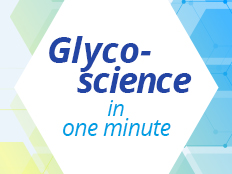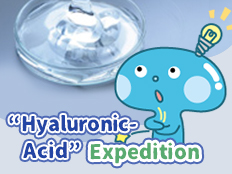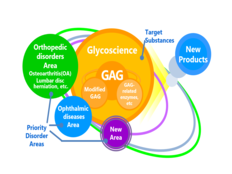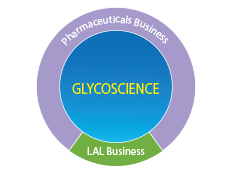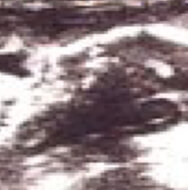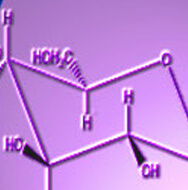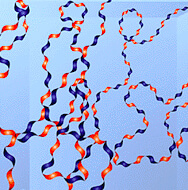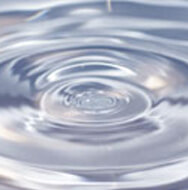Numerous cosmetics and quasi drugs that use catch-phrases such as "retains moisture in the skin" are very popular, including skin lotion, skin cream, bath powder, lipstick, and facial cleansing cream. What is the main component that "retains moisture" ?
It is a substance called hyaluronic acid that exists universally in the extracellular matrix of vertebrates.
Extracellular matrix is a substance excreted by cells, and it provides the exterior environment in which the cell performs its normal activities. Bodies of animals each have a species-specific form. In contrast to metallic robots, they have properties such as tenderness and flexibility as well. Such properties derive from the extracellular matrix, more specifically by virtue of, for example, hyaluronic acid, chondroitin sulfate, and heparan sulfate that exist abundantly in the extracellular matrix (chondroitin sulfate and heparan sulfate are described in detail in Part 5 and Part 6). Among these, hyaluronic acid plays a crucial role in retaining moisture in the body, and is thus widely utilized in cosmetics and quasi drugs that use the catch-phrase "retains moisture in the skin".
In hyaluronic acid, water molecules densely occupy the spaces within the giant sugar chain. It is known that this causes the solution of hyaluronic acid dissolved in water to be sticky and it can hold large amounts of water. Because land creatures are surrounded by air, they are constantly facing the threat of dryness. The reason humans can retain firmness of skin and overcome dryness is due to the presence of hyaluronic acid. In this sense, hyaluronic acid functions as a "dryness protection suit" for cells.
In humans, especially high concentrations of hyaluronic acid are contained in the skin, joint fluid, naval cord, and vitreous body of the eye. However, hyaluronic acid is rapidly degraded, and its half-life is known to be approximately two weeks. There are some cells that synthesize hyaluronic acid such as the vitreous body cell, but the degradation rate is faster than the synthesis rate, and as a result, the amount of hyaluronic acid continues to decrease with growth. There are researches that report that the amount of hyaluronic acid in the skin is, defining the amount present at 20 years old as 1, decreased to approximately one sixth by the time a person is 80 years old.
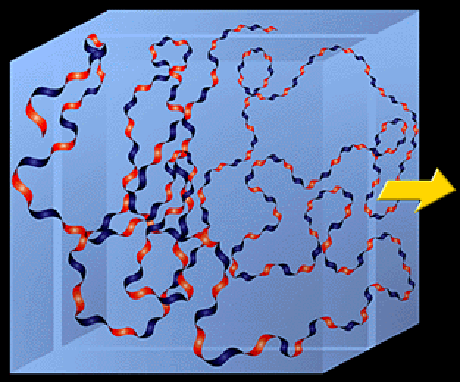
▲ Three-dimensional ribbon structure model of hyaluronic acid. The light-blue box represents the spread of hyaluronic acid molecule in solution. Interchanging blue and red tapes represent hydrophobic (blue) and hydrophilic (red) ribbon structures.
Does hyaluronic acid have any functions other than retaining moisture?
Another function of hyaluronic acid is to lubricate the sliding of cartilage and synovium in joints, and to absorb shock applied to the joint.
Imagine the engine of a car. The engine uses a lubricating oil to prevent burning. In the engine, pistons move rapidly inside the cylinders. Lubricating oil is essential to improve slippage and prevent burning. Similarly, hyaluronic acid contained in joint fluid and joint cartilage plays an important role improving slippage between joint tissues (cartilage and synovium) and absorbing shock applied on the joint. In other words ,joints move smoothly by virtue of hyaluronic acid.
Taking such properties of hyaluronic acid into consideration, it is in practical use as therapeutic drugs for disorders where joint cartilage is deformed from aging. It is also used as adjuvants in cataract surgeries and penetrating keratoplasty because its properties of viscosity and viscoelasticity are protect cells and tissues. Although it is not so well known, hyaluronic acid is one of the most frequently used sugar-derived medicines in Japanese hospitals.
It has been found from recent research that hyaluronic acid also has the function of suppressing inflammation and repairing tissues when cells are destroyed or inflammation occurs.
In addition, research on the various roles of hyaluronic acid such as in infection or fertilization, cell differentiation, cell migration, tissue morphogenesis, and wound healing is also under way.
Hyaluronic acid is already in use as medicine, and its application is expected to further expand to include fields such as regeneration medicine.
♦Glycoforum
In "Hyaluronan Today", which is a subcategory of "Glycoforum," new developments and research results related to hyaluronic acid are provided.
Hyaluronic Acid: Its Structure and Physical Properties
Reference
Longas M. O., et. al. : Evidence for structural changes in dermatan sulfate and hyaluronic acid with aging. Carbohydr. Res. 159, 127-136 (1987).

